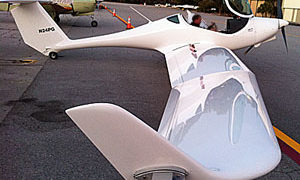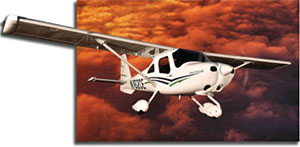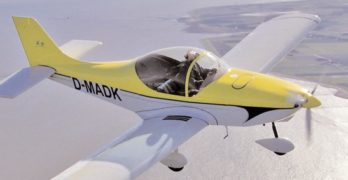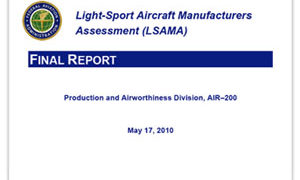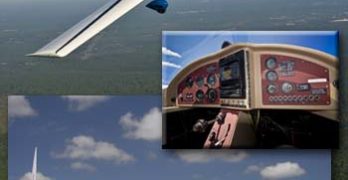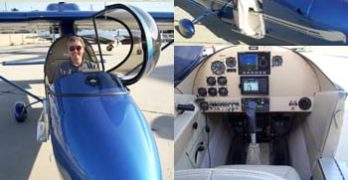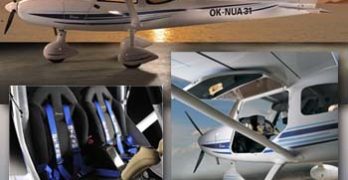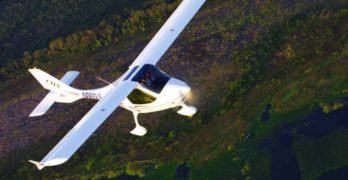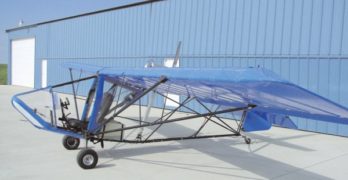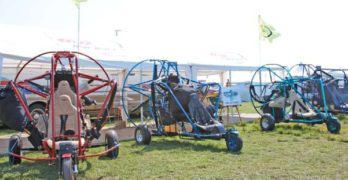Yesterday, I was again grateful for my residence at Spruce Creek Fly-In, the large airport community near Daytona Beach, Florida. Why? Because after a lucky last-minute phone call, I zipped over to the airport restaurant and went flying with Jim Lee in his new Phoenix. *** Now, I’m a soaring enthusiast, so a LSA motorglider already starts well up my wish list. But this Phoenix, whew! She’s simply gorgeous with slippery compound curves and the handling is marvelous. *** Much more than simply a soaring machine, Phoenix climbs like the proverbial homesick angel and can cruise faster than many LSA. It also comes standard with two wing configurations — 49 feet stepping down to 36 feet — so you really get two airplanes in one. (Not only that, but if you need to put Phoenix in a hangar, you can remove the long wingtips to squeeze down to a 34-foot span, hardly any wider than a “standard” LSA.) *** Inside the cockpit, the 43-inch wide space is handsomely appointed and you have a few controls and an instrument not typically found in LSA.
Search Results for : CT AND hand control
Not finding exactly what you expected? Try our advanced search option.
Select a manufacturer to go straight to all our content about that manufacturer.
Select an aircraft model to go straight to all our content about that model.
A Raging Debate… IFR, IMC, VMC, and LSA
In the last month, I’ve received many calls and emails from more than a dozen flight schools. Here, I will try to reduce the confusion — and some alarm — regarding IFR (flying by instrument reference) and LSA.
ASTM’s F37 committee is comprised of people with technical knowledge and they have done the nearly-impossible: start with a blank sheet of paper and create aircraft certification standards for the LSA sector… in just five years, and on the leanest of budgets. These volunteers from many countries created a series of standards, one of which is the Design and Performance Standard. Following a positive vote by committee members, all have been accepted by FAA.
For more than three years another subcommittee has tried to create an IFR standard that has yet to find agreement. Until consensus may be found and to provide an interim defensive position for the committee and for manufacturers, F37 added a point to the revised but yet-to-be-accepted-by-FAA D&P Standard.
Breezer Aircraft and the New Breezer II
Close to Perfect
It usually takes more than one
try to get something right. To
get close to a perfect aircraft
usually takes many iterations, but
Breezer Aircraft has come very close
to producing a wonderful light sport
aircraft with their Breezer II.
We’ve seen the Breezer before when
the U.S. importer brought the thennew
model to AirVenture Oshkosh
’05. I flew it that year and recently
got the chance to fly the Breezer II.
While many of the good qualities
found in the earlier model were
retained, some nice improvements
have been made. But it isn’t the airplane
that is the real story. As experienced
airplane buyers know, it is
often the company behind the airplane
that is the main story.
Breezer’s Brief Design History
The design history is brief because the Breezer
is a new aircraft, not seen before ’05 except during
its early development. That older, original Breezer
was produced under agreement by Comco-Ikarus,
the same folks that make one of Germany’s bestselling
ultralights (a different class than American
ultralights), the C-42.
Government and LSA — U.S. and Abroad
Recent government actions cast a shadow over the freedom enjoyed by the LSA community. When issuing the new rule in 2004, FAA relinquished direct involvement with aircraft certification in an admirable display of innovative experimentation. The new approach depends on industry consensus standards, often referred to as “ASTM standards,” to certify an aircraft. *** In May this year, FAA issued its Manufacturers Assessment report following the agency’s visit to 30 manufacturers or their U.S. importers (mostly the latter). The report is “tough love” in that it shows many ways the industry must improve… with an implied “or else” lurking in the margins. Top FAA and NTSB officials have publicly and repeatedly said they are generally satisfied with the safety record of this five-year-old industry. But many in FAA are accustomed to government having a significant oversight role in the manufacture of aircraft and that was upended with the LSA movement.
Breezer II, Part II, Act I… All-Metal LSA Redux
It didn’t work out the first time. Breezer I wasn’t quite mature for market. The import structure was unwieldy adding cost and distancing the customer from the source. As Breezer Aircraft took over manufacturing of the all-metal LSA, Breezer II arrived in 2008 joining new leadership in Europe with fresh representation in the USA. *** As of Sebring 2010, central Florida light aircraft guru Mike Zidziunas — or simply “Mike Z” — will become the point man for Breezer Aircraft USA. And he’ll handle things differently from most LSA sellers. His plan is more like that used successfully by Cirrus. The source of the airplanes handles the whole country using representatives in various areas as touch points. “I feel that the conventional dealer network is ponderous and it’s difficult to control the quality of service,” expressed Mike. “To address service after the sale, when we deliver the airplane we offer as part of the purchase of the airplane a 5-hour FITS-style pilot training program.
New Tandem SLSA Headed to Market
Most of our tandem Special Light-Sport Aircraft — Legend Cub, Courier, SportCub, Savage, Hornet, Hawk, and SkyArrow — are recreational airplanes. Except for the last one (Italy’s smooth, composite Sky Arrow) most might also fall into the “bush” category in that they are slower-flying, fabric-covered, rugged aircraft suitable for landing on unimproved airstrips. *** A brand-new tandem, not yet officially a SLSA, is the MySky MS-1, which I call a “performance tandem.” MS-1 aims to go as fast as the category allows (120 knots) using its beefy 120-hp Jabiru 3300 powerplant. MySky’s entry also plans a deluxe interior not found in most currently-approved tandem SLSA. *** Recently I trekked to California to fly a few hours in the A-16 Sport Falcon from AviaDesign.
Handsome New High Wing… Sirius — SLSA #103
Most folks following the Light-Sport Aircraft development know the Sting, refreshed for the U.S. market with the S3 model. I covered the development announcement of TL Ultralight’s new high wing. Now, welcome to the TL3000 Sirius as the newest SLSA to hit the market in a blur of new offerings seemingly triggered after the industry hit #100. *** Importer SportairUSA maneuvered their low-wing, all-carbon-fiber Sting S3 into one of the best-equipped LSA on the market. Adding a high wing gives the company new versatility to meet market interest. *** I see the potential for keen demand from GA pilots, especially those legions trained in high-wing, yoke-controlled Cessna models. Sirius’ 48-inch wide cabin is nine inches wider than a C-172 and it can haul 420 pounds of payload even when topped off with 30 gallons of fuel that can take you 800 miles (numbers will vary depending how you equip a Sirius).
Redesigned Flight Design CTLS
All photos by EAA Chief Photographer, Jim Koepnick
This article appears on ByDanJohnson.com thanks to permission granted by EAA and the willingness of author, Ed Downs. I’ve had the pleasure to fly with many expert pilots but the very best aircraft checkout I’ve ever received came from Ed. He’s a good pilot, that’s a given. But he is also very adept at giving you a solid expectation of what to expect. I think you’ll agree after you read this article. –Dan Johnson *** Note this article is presented without charge.
Are LSA Growing Up?
New special light-sport aircraft (SLSA) enter the
market on an almost weekly basis. Many of the
early SLSA entrants were makeovers of existing
European advanced ultralight designs or adapted
versions of post-World War II training airplanes.
Flight Design USA has now introduced the CTLS,
defined as a second-generation S-LSA from the
German-based Flight Design GmbH. Is this new
S-LSA better than the first CTs sold?
T-Bird I and the Future
An Easy-Flying Ultralight
Let’s see. A single-seat plane that can be purchased as an ultralight,
assuming your engine selection doesn’t push it over Part
103’s weight limit, or built from a kit and registered as an
Experimental-class aircraft, or purchased as a light sport aircraft
once the manufacturer meets the ASTM certification. What’s a pilot to do?
That’s the conundrum facing T-Bird I shoppers. This single-seater can be
a Part 103-compliant ultralight when using a Rotax 277, still available on
the used-engine market, though no longer supplied from Rotax’s Austrian
factory. Few prospective owners would select this engine, yet a more powerful
engine would push the T-Bird I over the Part 103 weight limit. Does that
leave only the Experimental amateur-built kit
option?
The answer is no, and yes. To explain this apparent
contradiction, a kit-built T-Bird I with a larger
Rotax engine or the 60-hp HKS 700E engine could
still qualify under the 51% rule.
To Infinity…and Beyond!
The world of light-sport
aircraft (LSA) includes five
classes of aircraft-airplanes,
gliders, powered parachutes, weightshift-
control aircraft (commonly
called trikes), and lighter-than-air
aircraft (balloons and airships).
While fixed-wing airplanes may be
the most prolific, they are not the
only way for flight enthusiasts to
take to the sky. Weight-shift trikes
and powered parachutes (PPCs) are
also popular modes of flights. Each
offers a different experience to pilot
and passenger.
Some fixed-wing pilots claim
no interest in powered parachutes.
While PPCs certainly aren’t fast,
they do offer one of the best viewing
platforms in aviation and have
attracted a higher percentage of
non-pilots as buyers than any other
aviation segment. That fact alone
should cause more aviators to look
closely at them.
So far three powered parachute
companies have obtained special
LSA (S-LSA) approval for their
models. The first to achieve this
was the Summit 2 from Summit
Powered Parachutes in April 2006.
- « Previous Page
- 1
- …
- 8
- 9
- 10
- 11
- 12
- …
- 62
- Next Page »


